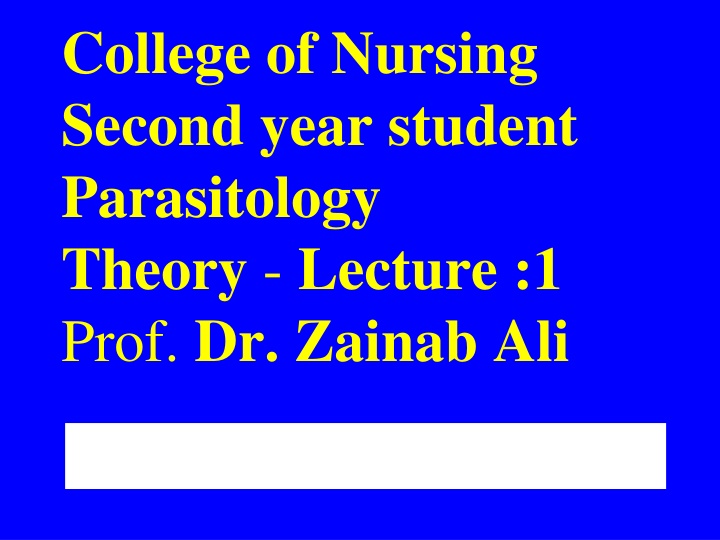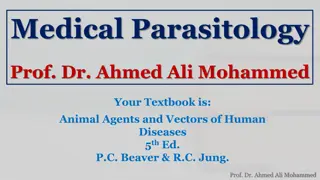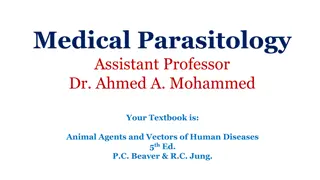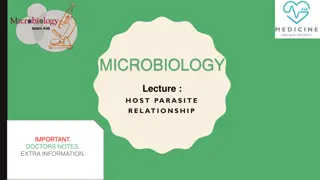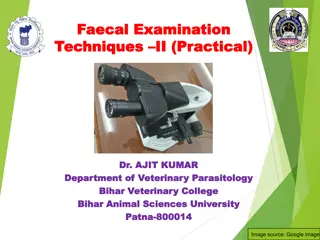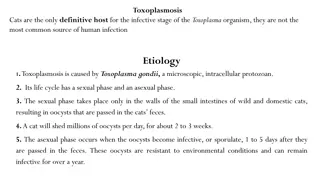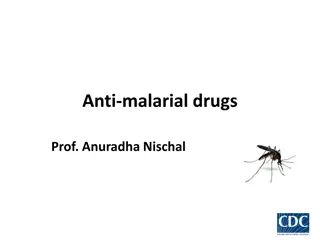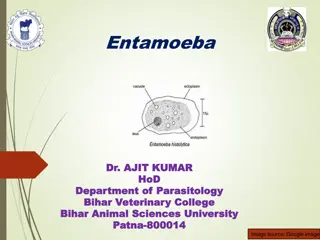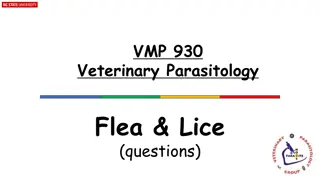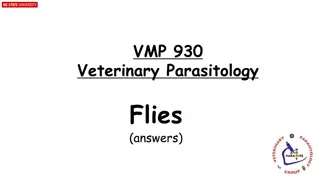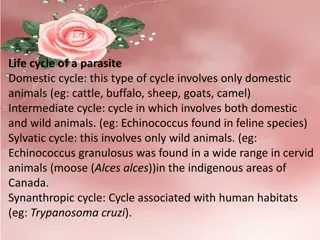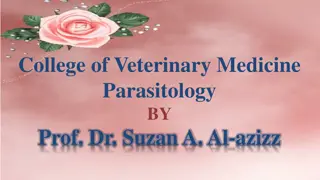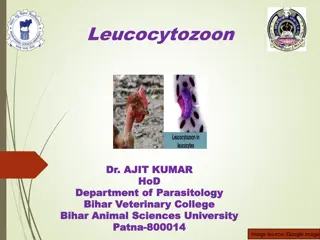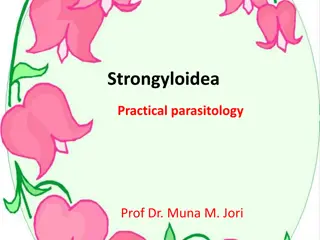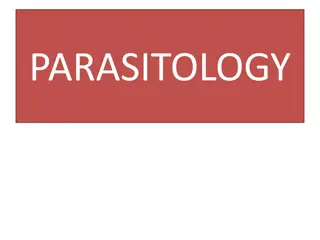Medical Parasitology: Understanding Host-Parasite Relationship
Medical parasitology is the study of organisms living in the human body and their medical significance. Parasites derive nourishment from a host, which supports their survival. This field covers various parasites such as protozoa, helminths, and certain arthropods. Parasites exhibit characteristics such as being eukaryotes, absorbing organic chemicals, and may be motile. Different types of parasites include ectoparasites, endoparasites, obligate parasites, facultative parasites, and accidental parasites. Understanding the different kinds of hosts, such as definitive hosts, is crucial in studying parasitology.
Download Presentation

Please find below an Image/Link to download the presentation.
The content on the website is provided AS IS for your information and personal use only. It may not be sold, licensed, or shared on other websites without obtaining consent from the author.If you encounter any issues during the download, it is possible that the publisher has removed the file from their server.
You are allowed to download the files provided on this website for personal or commercial use, subject to the condition that they are used lawfully. All files are the property of their respective owners.
The content on the website is provided AS IS for your information and personal use only. It may not be sold, licensed, or shared on other websites without obtaining consent from the author.
E N D
Presentation Transcript
College of Nursing Second year student Parasitology Theory - Lecture :1 Prof. Dr. Zainab Ali
Medical Parasitology Introduction
Medical parasitology is the science that deals with organisms living in the human body and the medical significance of this host-parasite relationship. A parasite: is a living organism, which takes its nourishment and other needs from a host.
host : is an organism which supports the parasite. The parasites included in medical parasitology are protozoa, helminthes, and some arthropods.
Characteristic of Parasites Eukaryotes. Absorb or ingest organic chemicals. May be motile via pseudopods, cilia, or flagella. Parasitic flatworms and round worms are called helminths.
DIFFERENT KINDS OF PARASITES 1 Ectoparasite a parasitic organism that lives on the outer surface of its host, e.g. lice, ticks, mites etc. 2 Endoparasites parasites that live inside the body of their host, e.g. Entamoeba histolytica.
3 Obligate Parasite-This parasite is completely dependent on the host during a segment or all of its life cycle, e.g.Plasmodium 4 Facultative parasite an organism that exhibits both parasitic and non-parasitic modes of living and hence does not absolutely depend on the parasitic way of life, but is capable of adapting to it if placed on a host. E.g. Naegleria.
5 Accidental parasite when a parasite attacks an unnatural host and survives. E.g. Hymenolepis
* DIFFERENT KINDS OF HOSTS 1 Definitive host a host that harbors a parasite in the adult stage or where the parasite undergoes a sexual method of reproduction. 2 Intermediate host- harbors the larval stages of the parasite or an asexual cycle of development takes place. In some cases, larval development is completed in two different intermediate hosts, referred to as first and second intermediate hosts.
3.Reservoir host a host that makes the parasite available for the transmission to another host and is usually not affected by the infection. 4.Natural host a host that is naturally infected with certain species of parasite. 5 Accidental host a host that is under normal circumstances not infected with the parasite.
Relationships between organisms Any organism that spends a portion or all of its life cycle intimately associated with another organism of a different species is considered as (symbiote) and this relationship is called symbiosis. The following are the three common symbiotic relationships between two organisms:
1- Mutualism: two organisms living together, the two organisms benefit.The protozoa, which depend entirely on a carbohydrate diet, acquire their nutrients from termites. In return they are capable of synthesizing and secreting celluloses; the cellulose digesting enzymes, which are utilized by termites in their digestion
2- Commensalism an association in which the commensal takes the benefit without causing injury to the host. E.g. Most of the normal floras of the humans body can be considered as commensals
3-Parasitism - an association where one of the partners is harmed and the other lives at the expense of the other. E.g. Worms like Ascaris lumbricoides reside in the gastrointestinal tract of man, and feed on important items of intestinal food causing various illnesses
INTRODUCTION of Protozoa Protozoa (singular, protozoan), from the Greek protos and zoon meaning first animal , are members of eukaryotic. They may be distinguished from other eukaryotic by their ability to move at some stage of their life cycle and by their lack of cell wall. Occurrence of protozoa are found in all moist habitats. They are common in sea, in soil and in fresh water.
These organisms occur generally as a single cell. Colonies of protozoa might also occur in which individual cells are joined by cytoplasmic threads and form aggregates of independent cells. However, distinct types of protozoa, include a resistant cyst (non- motile) stage to survive adverse environmental conditions, such as desiccation, low nutrient supply, and even anaerobiosis.
General Concepts of Protozoa: Generally unicellular Eukaryotic organisms Smallest could only be seen with an EM. completing all necessary life activities independently Motile with A-Pseudopodium Amoeba, Entamoeba histolytica. Flagellum , Giardia lamblia Cilia - Balantidium coli.
Reproduction Binary fission, the most common form of reproduction among medical protozoa, is asexual; Multiple asexual division occurs in some forms; Sexual reproduction: takes place within the definitive host and usually results in the formation of a zygote; Both sexual and asexual reproduction occur in the Apicomplexa
Life cycle and type of life cycle Life cycle : the whole biological course of growth, development and reproduction of a parasite The direct type : only one host (final host, no intermediate host). e.g., Ascaris lumbricoides. . The indirect type : life cycle with more than one host (intermediate host and final host) . e.g., plasmodium.
Parasites Uptake of nutrition Pathogens utilize nutrition from host environment for their development and reproduction. Helminthes (nematodes or flukes --- have a gut and mouth) feed upon the surrounding tissues, body fluids or even host cell debris. Tapeworms (no gut or mouth) reply on the host s daily intake by their body wall absorbing for their own food.
Mechanical damage of parasites Entering the cells: some protozoa must live in certain cells and reproduce. Finally result in the rupture of the host cells. Migration or penetration through tissue or organ Blockage and pressure: the intestinal lumen can be blocked by worms. Hydatid cyst in liver may reach volumes of 1-2 litres, it can cause severe damage to organ. Affect the growth , development Damage to the skin or muscle.
Toxic and hypersensitivity Toxin: many parasites can introduce or secret toxin and cause damage to host. Hypersensitivity: the metabolites, secretion, excretion or other products of parasites or dead worms may act as foreign antigen, to stimulate the immune system of host to produce immune response or hypersensitivity. Hypersensitivity is harmful to host, which may lead to severe or even fatal reaction.
ex. Sudden rupture of hydatid cysts with release of large amounts of fluid could result in severe allergic reaction, sometimes lead to shock or death of patients
Basic factors of transmission of parasitic diseases Parasitic diseases Infectious diseases Transmission The source of the infection The routes of transmission The susceptible host
Source of the infection Patient : persons who have parasites in their body and show clinical symptoms Carrier : persons who have parasites in their body, not show symptoms Reservoir host : animals that harbor the same species of parasites as man, the parasites in animals sometimes can be transmitted into human
Routes of transmission Congenital transmission : from mother to infant , e.g., toxoplasmosis Contact transmission : direct contact or indirect contact with patients or infected animals, e.g., Trichomonas vaginalis Food transmission : the infectious stage of parasites contaminated food / the meat of the intermediate hosts containing infectious stage of parasites , e.g., Clonorchiasis
Routes of transmission Water transmission : drink or contact the water contaminated the infectious stage of parasites, e.g., schistosome, Entamoeba histolytica Soil transmission : soil contaminated by feces containing the certain stage of parasites which can develop into infective stage, e.g., Ascaris lumbricoides . Arthropod transmission : vectors of certain parasitic diseases, e.g., plasmodium
Susceptible host In general, people is the susceptible host (Why?). The parasite reaching a susceptible host must gain entrance and set up a favorable residence in order to complete its life cycle and cause the transmission of parasitic diseases.
Prevention measures of parasitic diseases Controlling the source of the infection: treatment of the patients, carriers and reservoir hosts Blocking the routes of transmission: managing feces and water resource, controlling or eliminating vectors and intermediate hosts Protecting the susceptible hosts: paying attention to health education/ personal hygiene, changing bad working/ eating habit, etc.
